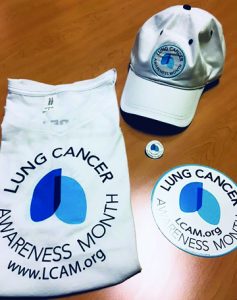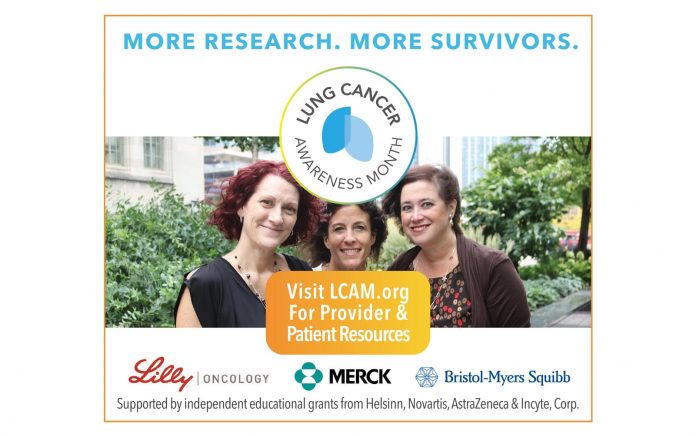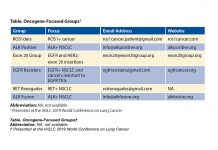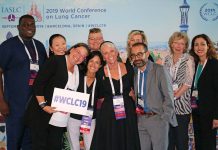By Keightley Amen, BA, ELS
Posted: December 2017
While many people remain unaware of the advancements in the field of lung cancer and research spending still lags behind the funds spent to combat other types of cancer,2 lung cancer is the leading cause of cancer death worldwide.1
To bolster research spending, raise public awareness, and reduce the widespread stigma  associated with the disease, the International Association for the Study of Lung Cancer (IASLC) coordinated the second annual Lung Cancer Awareness Month Coalition (LCAM) in November 2017. LCAM is a cooperative effort among nonprofit lung cancer advocacy organizations, industry, healthcare professionals, and patients – and the campaign gained tremendous support and momentum in its second year.
associated with the disease, the International Association for the Study of Lung Cancer (IASLC) coordinated the second annual Lung Cancer Awareness Month Coalition (LCAM) in November 2017. LCAM is a cooperative effort among nonprofit lung cancer advocacy organizations, industry, healthcare professionals, and patients – and the campaign gained tremendous support and momentum in its second year.
LCAM kicked off the month of November with a media program at The National Press Club in Washington, DC. A prestigious panel of physicians, LCAM partners, and survivors discussed lung cancer’s vast threat; the stigma associated with the disease; current advocacy efforts; and the research, diagnosis, and treatment breakthroughs bringing new hope to patients and their families.
Dusty Donaldson, survivor and a cochair of the Lung Cancer Action Network, served as moderator. Experts included the IASLC CEO Fred Hirsch, MD, PhD; Melissa Culligan, RN, MS, director of clinical research in thoracic surgery at the University of Maryland and chair of the International Thoracic Oncology Nursing Forum; Jennifer King, PhD, director of science and research at the Lung Cancer Alliance; and John F.P. Bridges, PhD, associate professor in the Johns Hopkins Bloomberg School of Public Health. Other partner organizations on hand to engage the press included the Addario Lung Cancer Foundation, American Lung Association, Life & Breath Rally, Lung Cancer Alliance, Lungevity, and Cancer Survivors Against Radon.
Following the kickoff and throughout the month, LCAM ran online banner and video ads, as well as a halfpage advertisement in the New York Times. In addition, LCAM continued to leverage social media: The campaign has more than 40,000 Facebook followers and 220 Twitter followers. The IASLC encourages its members to use #LCAM, #LCSM, #HOPELIVES, #MoreResearchMoreSurvivors, when talking about lung cancer on social media so that all parties working to combat the disease can consolidate their efforts.
LCAM aims to include as many partners as possible, including international groups and allied health. For 2017, the following organizations joined the collaborative effort as official partners, bringing the number to more than 30:
• National Lung Cancer Forum for Nurses
• Clifton F. Mountain Foundation for Research and Education in Lung Cancer
• Pembe Hanim (Turkey)
• Citizens for Radioactive Radon Reduction
• International Thoracic Oncology Nurses Forum
• Israeli Lung Cancer Foundation
• Polish Lung Cancer Group
For a full list of LCAM partners, visit www.lcam.org/partners/.
A critical part of the LCAM campaign is to share and promote the stories of lung cancer survivors and their caregivers and families. On the LCAM website, many have posted their “Stories of Hope. More Time. More Life.” Some remind readers how lung cancer can happen to anyone, others describe the research that saved their lives, and many share a message of hope and advocacy. LCAM encourages more people to share their stories at www. lcam.org/share-your-story and receive an LCAM kit, including a hat, T-shirt, pin, and car magnet. Additionally, LCAM is offering complimentary resources to providers that will include IASLC lung cancer information as well as items to share with their patients/survivors and caregivers. To receive your provider resources, visit, www.lcam.org/provider-resources/ ✦
References
1. World Health Organization. Cancer fact sheet. Accessed October 27, 2017, from http://www.who. int/mediacentre/factsheets/fs297/en/.
2. National Institutes of Health. Estimates of funding for various research, condition, and disease categories. Accessed October 27, 2017, from https:// report.nih.gov/categorical_spending.aspx.











